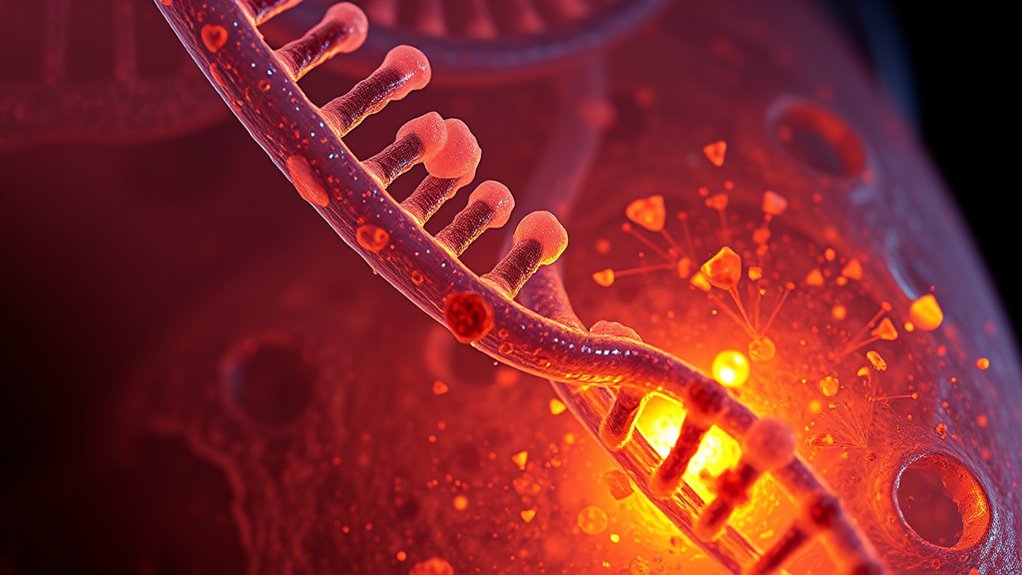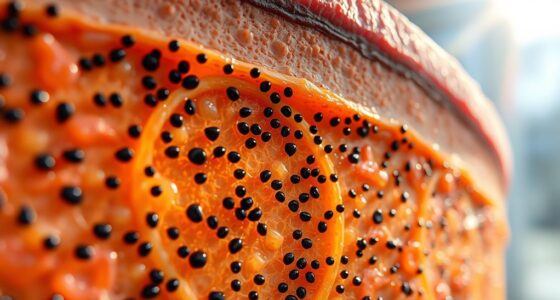When you’re exposed to UV radiation, it penetrates your skin and damages your DNA by causing abnormal bonds between nucleotide bases, forming structures called pyrimidine dimers. This distortion alters the DNA’s normal shape, disrupting cellular functions and increasing the chance of mutations. Your cells try to repair this damage through specialized mechanisms, but if the damage persists or overwhelms the repair systems, it can lead to skin aging or skin cancer. Discover more about how your body fights back.
Key Takeaways
- UV radiation causes DNA pyrimidine dimers, distorting the DNA helix and impairing normal cellular functions.
- Cells activate nucleotide excision repair to identify and remove UV-induced DNA lesions.
- Damage from UV-generated reactive oxygen species adds oxidative stress, further harming DNA and other cellular components.
- Persistent or overwhelming UV damage can lead to mutations, increasing the risk of skin aging and cancer.
- Protective measures like sunscreen and clothing help reduce UV-induced DNA damage at the cellular level.

Ultraviolet (UV) radiation from the sun can cause significant damage to your DNA, leading to mutations that may result in skin aging, sunburns, or even skin cancer. When UV rays penetrate your skin, they can directly affect your DNA molecules by inducing the formation of abnormal bonds between nucleotide bases. These bonds, known as pyrimidine dimers, distort the DNA helix and disrupt normal cellular functions. If left unrepaired, these mutations can accumulate, increasing your risk of developing skin abnormalities and malignancies over time.
Fortunately, your cells are equipped with DNA repair mechanisms that respond to UV radiation effects. These repair systems, such as nucleotide excision repair (NER), act quickly to identify and correct UV-induced damage. When a pyrimidine dimer forms, specialized enzymes recognize the distortion in the DNA structure and excise the damaged section. DNA polymerase then fills in the missing nucleotides, and DNA ligase seals the new strand into place. This process helps maintain genetic integrity and prevents mutations from becoming permanent.
Cells repair UV damage swiftly through nucleotide excision repair, excising and replacing damaged DNA to preserve genetic stability.
However, the efficiency of these DNA repair mechanisms can vary depending on factors like age, genetic predisposition, and overall health. If the repair processes are overwhelmed or faulty, damaged DNA may persist longer, increasing the likelihood of errors during cell division. These errors can lead to mutations that alter gene function, potentially causing cells to grow uncontrollably or evade apoptosis, which are hallmarks of cancer development.
The effects of UV radiation extend beyond direct DNA damage. UV exposure also generates reactive oxygen species (ROS), which can indirectly damage DNA, proteins, and lipids within your cells. This oxidative stress further complicates the cellular response, challenging your body’s ability to maintain cellular health. Your skin cells rely heavily on a balance between damage and repair; when UV radiation effects outpace repair capacity, visible signs like premature aging, wrinkles, and sunspots appear.
To mitigate these UV radiation effects, it is crucial to adopt protective measures such as wearing broad-spectrum sunscreen, seeking shade during peak sunlight hours, and wearing protective clothing. These strategies help reduce the burden on your DNA repair mechanisms and lower your risk of long-term skin damage. Understanding how UV radiation impacts your cellular DNA underscores the importance of Sun safety and proactive skin health practices to preserve your overall well-being.
Frequently Asked Questions
How Does UV Exposure Vary Across Different Skin Types?
You’ll notice UV exposure affects different skin types uniquely. Skin pigmentation, especially melanin, provides natural protection by absorbing UV rays, so individuals with darker skin generally experience less damage. Lighter skin has less melanin, making it more vulnerable to UV-induced harm. This variation means people with less melanin need to be extra cautious, wearing sunscreen and protective clothing, to minimize DNA damage and skin cancer risk.
Can DNA Repair Mechanisms Fully Reverse Uv-Induced Damage?
Your cells have DNA repair mechanisms that can often fix UV-induced damage, but they can’t always fully reverse it. When UV rays cause thymine dimers or other mutations, cellular mechanisms like nucleotide excision repair work to correct these errors. However, if the damage is extensive or persists over time, these repair processes may fall short, increasing the risk of mutations and skin issues. So, full reversal isn’t always guaranteed.
What Are the Long-Term Effects of Repeated UV Exposure?
Repeated UV exposure causes long-term DNA mutations, which silently accumulate and increase your risk of skin cancer. While your skin may appear unchanged, cellular aging accelerates, leading to wrinkles and loss of elasticity. These effects contrast sharply with your skin’s initial resilience. Over time, this damage weakens your skin’s defenses, making it more vulnerable to further harm, underscoring the importance of sun protection.
Do Genetic Factors Influence UV Susceptibility?
Yes, your genetic factors influence UV susceptibility. If you have a genetic predisposition, your body may produce less effective DNA repair enzymes, making it harder to fix UV-induced damage. This increases your risk of skin problems and skin cancer. So, your genes play a role in how well your skin responds to UV exposure, affecting your overall vulnerability and the need for extra sun protection measures.
How Effective Are Sunscreens at Preventing DNA Damage?
Did you know that broad-spectrum sunscreens block about 98% of UV rays? They’re quite effective at preventing DNA damage by targeting molecular mechanisms responsible for UV-induced harm. Sunscreen formulations with active ingredients like zinc oxide and avobenzone absorb or reflect UV radiation, reducing the risk of mutations. However, consistent and proper application is essential for maximum protection, especially during prolonged sun exposure.
Conclusion
So, next time you bask in the sun without protection, remember—your cells are quietly fighting off UV damage, hoping you’ll notice. Ironically, those rays that promise warmth and beauty can secretly cause DNA harm, setting the stage for future problems. It’s a reminder that what feels harmless now might be a ticking time bomb for your cells. So, enjoy the sunshine, but don’t forget—your DNA’s privacy is more fragile than you think.









